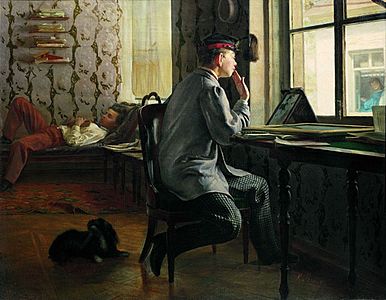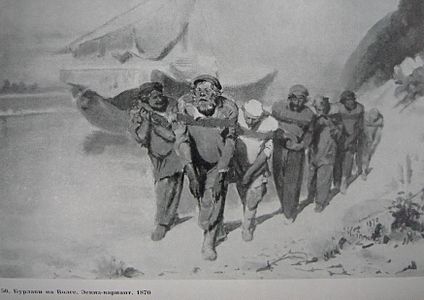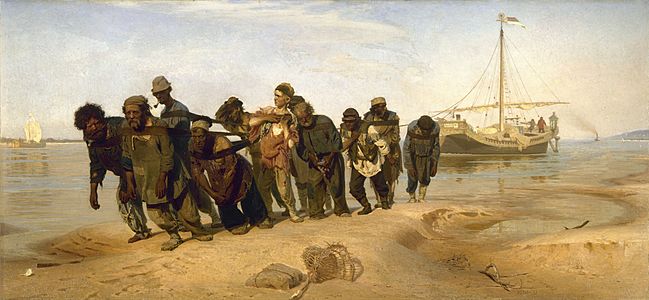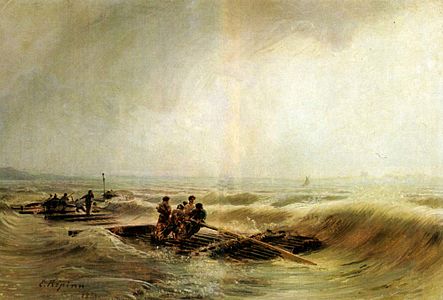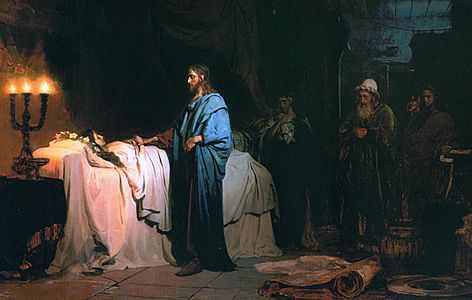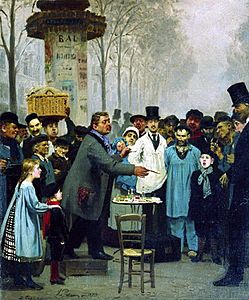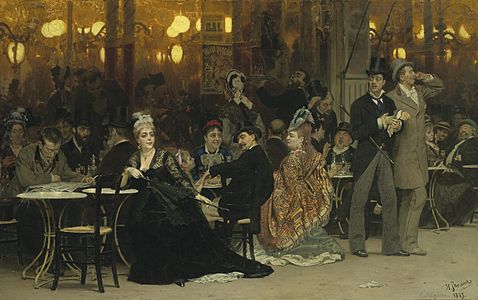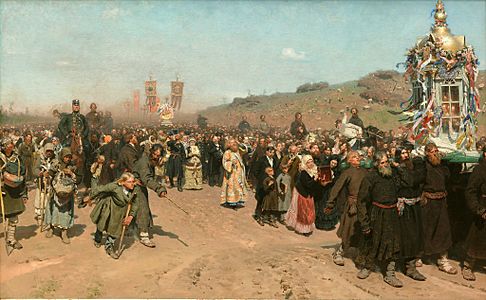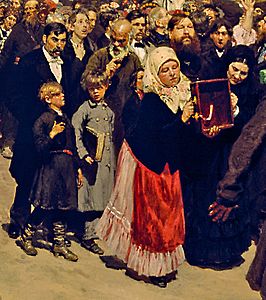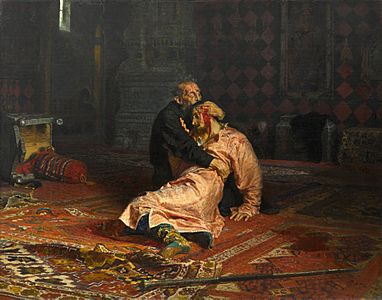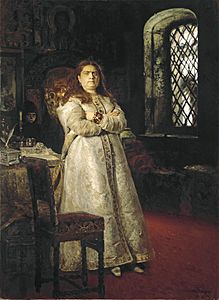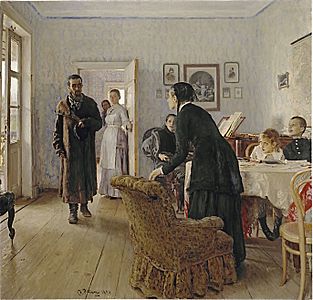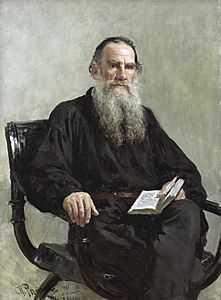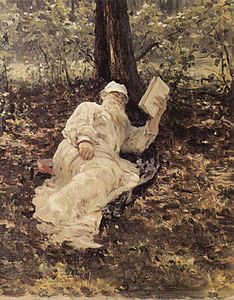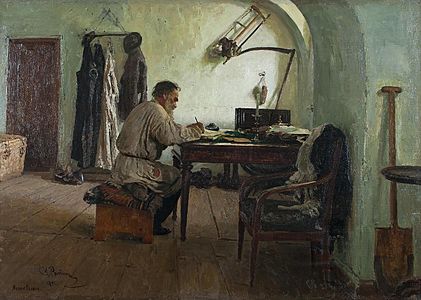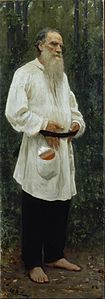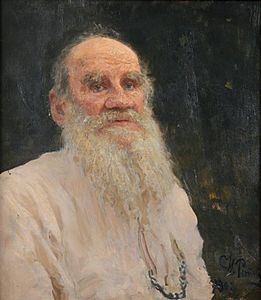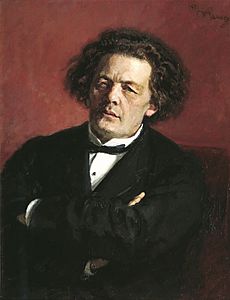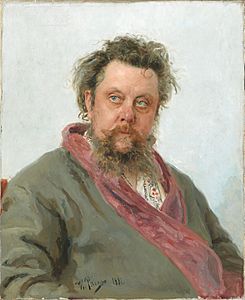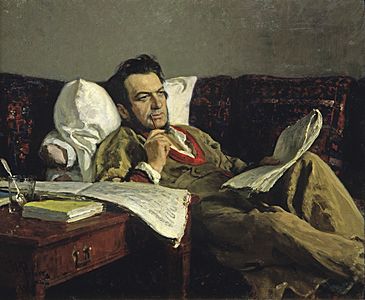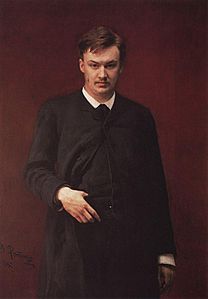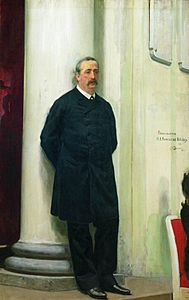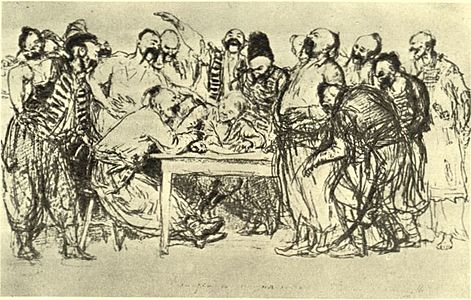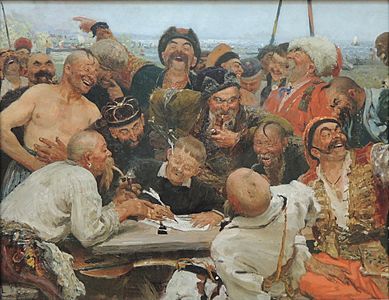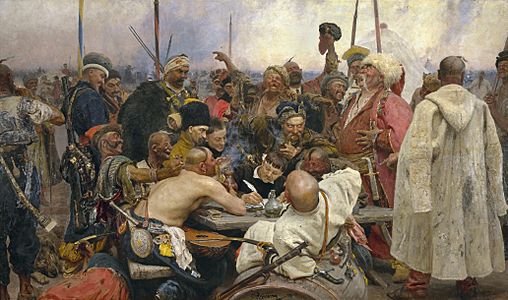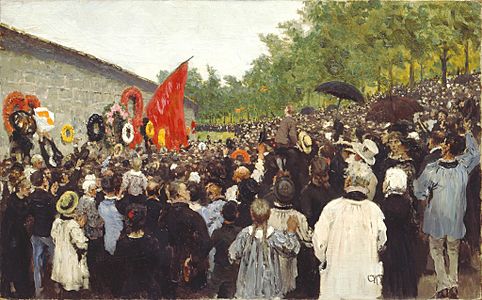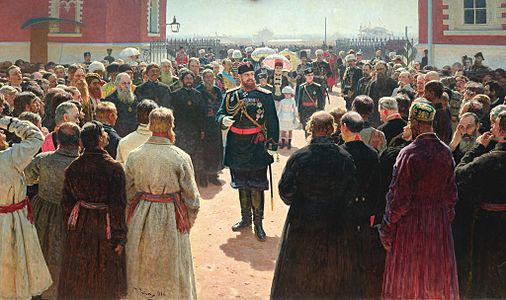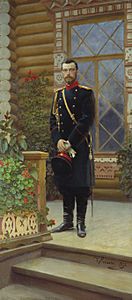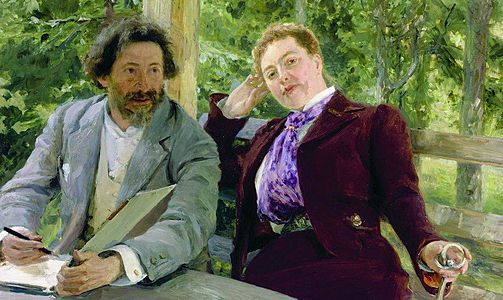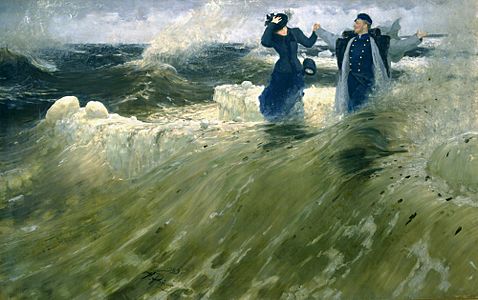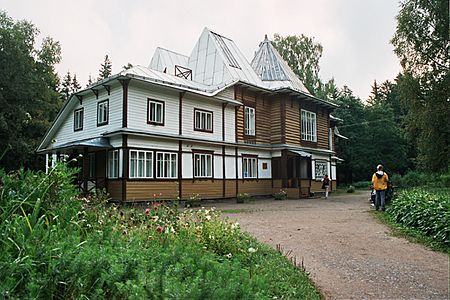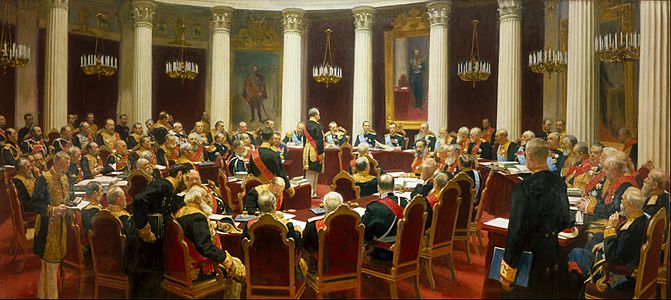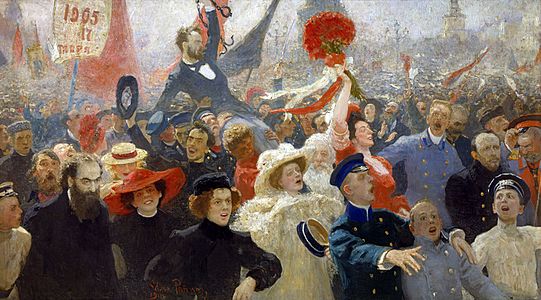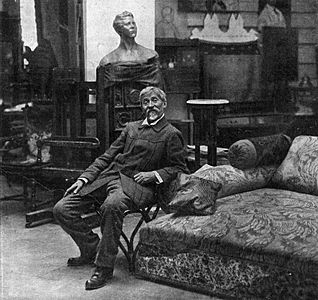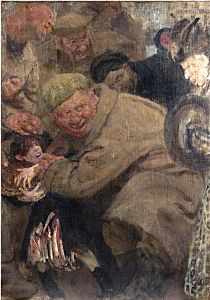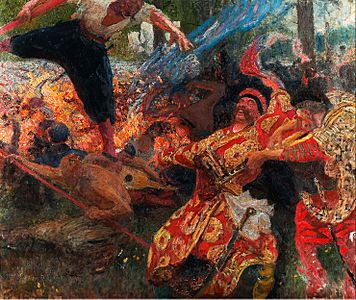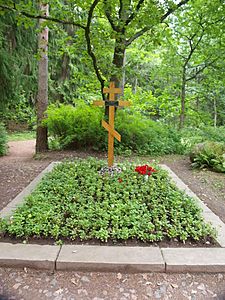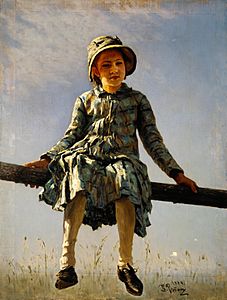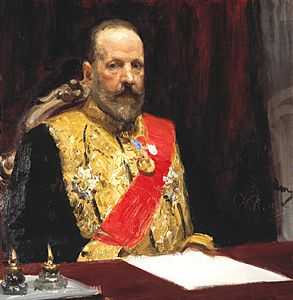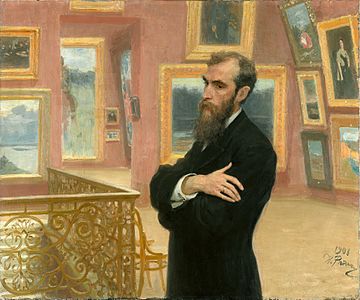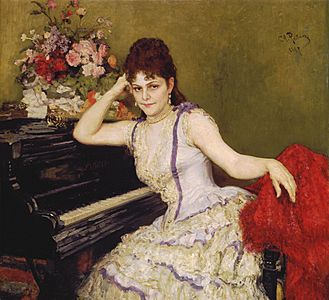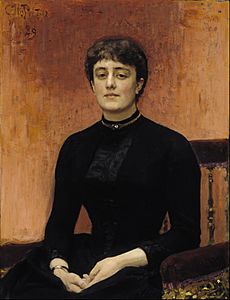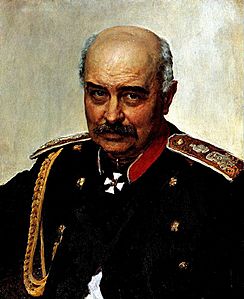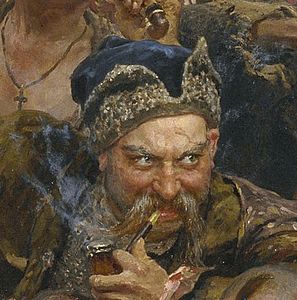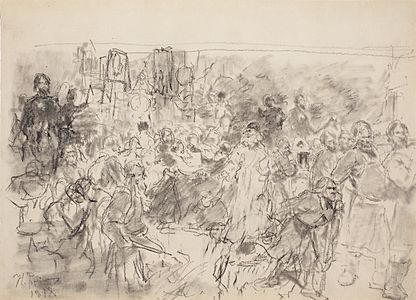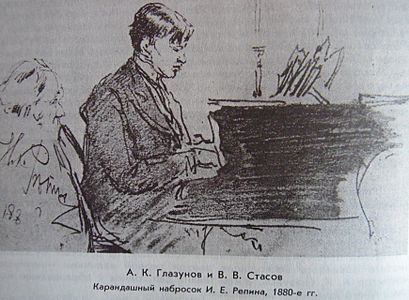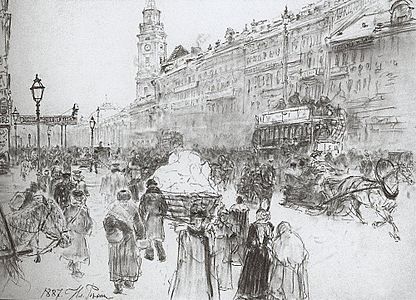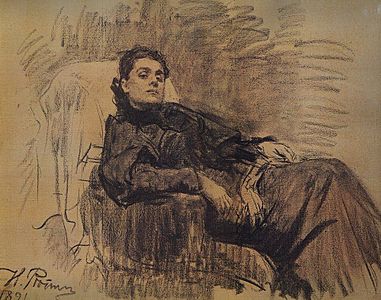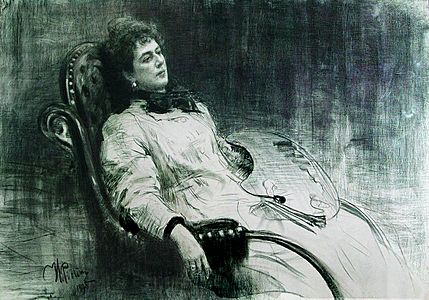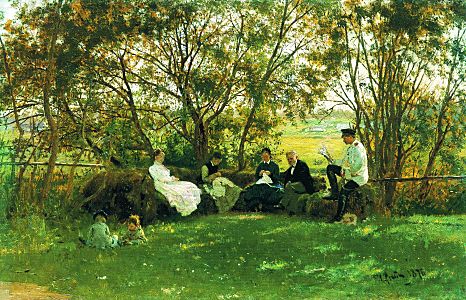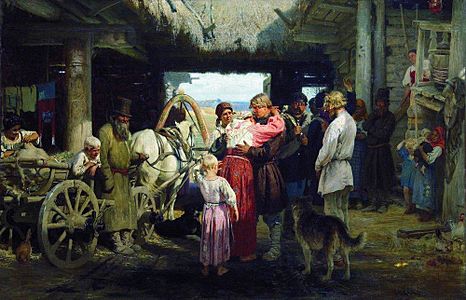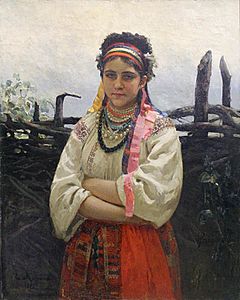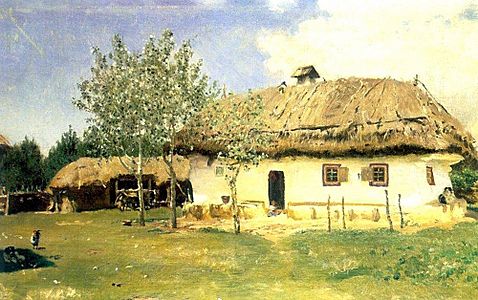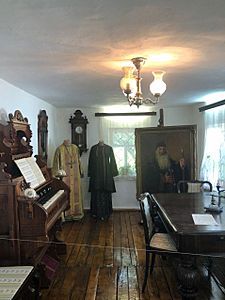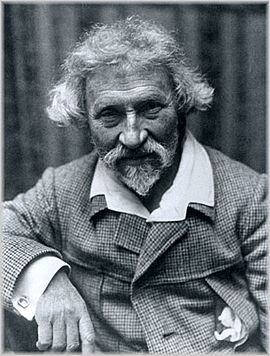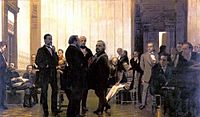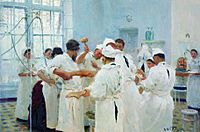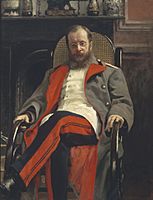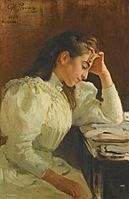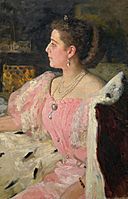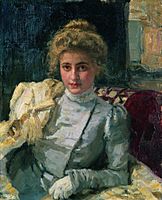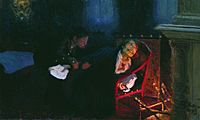Ilya Repin facts for kids
Quick facts for kids
Ilya Repin
|
|
|---|---|
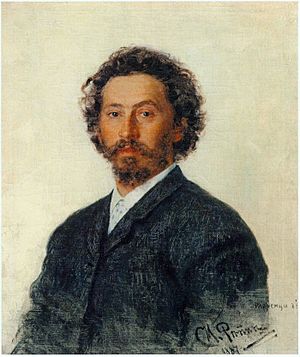
Self-portrait (1887), Tretyakov Gallery, Moscow
|
|
| Born |
Ilya Yefimovich Repin
5 August [O.S. 24 July] 1844 |
| Died | 29 September 1930 (aged 86) |
| Nationality | Russian |
| Education | Full Member Academy of Arts (1893) |
| Alma mater | Imperial Academy of Arts |
| Known for | Painting |
|
Notable work
|
Barge Haulers on the Volga (1870–1873) Religious Procession in Kursk Province (1880–1883) Reply of the Zaporozhian Cossacks (1880–1891) |
| Movement | Realism |
| Awards | Legion of Honour (1901) |
| Patron(s) | Pavel Tretyakov |
Ilya Yefimovich Repin (Russian: Илья Ефимович Репин, pronounced [ˈrʲepʲɪn]; 5 August [O.S. 24 July] 1844 – 29 September 1930) was a famous Russian painter. He was born in what is now Ukraine. Repin became one of the most well-known artists in Russia during the 19th century.
Some of his most important paintings include Barge Haulers on the Volga (1873), Religious Procession in Kursk Province (1880–1883), Ivan the Terrible and His Son Ivan (1885), and Reply of the Zaporozhian Cossacks (1880–1891). He was also famous for painting detailed portraits of important writers and artists of his time. These included Mikhail Glinka, Modest Mussorgsky, Pavel Tretyakov, and especially Leo Tolstoy, with whom he was good friends for a long time.
Repin was born in Chuguev, a town in the Russian Empire. His father was a soldier who later sold horses. Ilya started painting religious pictures (icons) when he was sixteen. He tried to get into the Imperial Academy of Fine Arts in Saint Petersburg but didn't succeed at first. However, he moved to the city in 1863, took art classes, and won his first awards in 1869 and 1871.
In 1872, after a trip along the Volga River, he showed his drawings at the Academy of Art. A royal family member, Grand Duke Alexander Alexandrovich, asked him to paint a large picture called The Barge Haulers of the Volga. This painting made him famous and started his career. He then spent two years in Paris and Normandy, where he saw the first Impressionist art shows. He also learned how to paint outdoors, a technique called en plein air.
In 1885, one of his historical paintings, Ivan the Terrible and His Son Ivan, caused a stir. It showed the Tsar (king) killing his own son in a fit of anger. The painting was even removed from public display for a while. But after this, Repin had many more successes and new art requests. In 1898, he bought a country house in Finland with his second wife. It was called The Penates and was close to St. Petersburg. Many important Russian people visited them there.
After street protests in 1905 were put down by the government, Repin quit his teaching job at the Academy of Fine Arts. He was happy about the February Revolution in 1917, which brought more freedom. However, he was shocked by the violence and terror that came with the Bolsheviks taking power in the October Revolution. Finland became independent from Russia in 1917, so Repin could no longer travel to St. Petersburg (which was renamed Leningrad). He even missed an exhibition of his own art there in 1925. Repin passed away on September 29, 1930, at 86 years old. He was buried at his home, The Penates, which is now a museum and a World Heritage Site.
Contents
- Biography
- Early Life and Art Training
- First Big Success
- Time in Paris and Normandy
- Moscow and "The Wanderers" (1876–1885)
- Repin and Tolstoy
- Repin and Russian Composers
- Reply of the Zaporozhian Cossacks
- Moving to Finland (1890)
- Revolution and Disillusion (1900-1905)
- War, Revolution, and Later Years (1917-1930)
- Portraits
- Drawings and Sketches
- Genre Painting
- Repin and Ukraine
- Style and Technique
- Legacy
- Gallery
- See also
Biography
Early Life and Art Training
Ilya Repin was born on July 24, 1844, in Chuguev, a town in the Russian Empire. His father, Yefim Vasilyevich Repin, was a soldier for 27 years. After leaving the army, he became a traveling merchant who sold horses.
Repin's mother, Tatiana Stepanovna Repina, was also from a soldier's family. The Repins had six children and lived comfortably. When Ilya was eleven, in 1855, he went to the local school where his mother taught. He showed a natural talent for drawing and painting. At thirteen, his father sent him to study with Ivan Bunakov, an icon painter. Ilya helped restore old icons and painted portraits of local people. By age sixteen, his skills were so good that he joined a group of artists who traveled around to paint icons and wall murals.
Repin had bigger dreams. In October 1863, he tried to get into the Imperial Academy of Arts in Saint Petersburg. He didn't get in on his first try. But he didn't give up! He rented a small room in the city and took drawing classes. In January 1864, he succeeded and was allowed to attend classes for free.
At the academy, he met the painter Ivan Kramskoi, who became his teacher and guide. Repin joined the first independent group of Russian artists that Kramskoi started. In 1869, he won a gold medal for his painting Job and His Brothers. He also met an important art critic, Vladimir Stasov, and painted a portrait of Vera Shevtsova, who would later become his wife.
First Big Success
In 1870, Repin traveled to the Volga River with two other artists. He made sketches of the landscapes and the barge haulers, who pulled boats along the river. When he returned to Saint Petersburg, his drawings of the boatmen were so good that a royal family member, Grand Duke Vladimir Alexandrovich, asked him to paint a large picture about them. This painting, Barge Haulers on the Volga, was finished in 1873. The next year, he won another gold medal for his painting The Resurrection of the Daughter of Jairus.
In May 1872, he married Vera Alexeievna Shevtsova. She traveled with him, and their first child, Vera, was born during a trip to Samara. They had three more children: Nadia, Yuri, and Tatyana. Their marriage was not easy, and they were married for fifteen years.
In 1873, Repin traveled to Italy and France with his family. He wrote that he felt it was important to paint about the lives of ordinary people, especially peasants, because he was from a peasant background himself.
Time in Paris and Normandy
Repin's painting Barge Haulers of the Volga was shown at an international exhibition in Vienna. This brought him his first international attention. He also received a grant from the Academy of Fine Arts, which allowed him to travel for several months. He visited Austria, Italy, and then Paris in 1873. He lived in Montmartre, a famous art district in Paris.
He stayed in Paris for two years. He painted scenes of Parisian life, including street markets, boulevards, and people from all walks of life. His main Russian painting created in Paris was Sadko (1876). This was a magical painting about an undersea kingdom. In 1876, his Sadko painting earned him a place in the Russian Academy of Fine Arts.
While in Paris in April 1874, he saw the first exhibition of Impressionist painters. He admired their freedom and how they captured light and color. He even painted a portrait of his wife, Vera, in a style similar to famous Impressionist artists. However, he felt that Impressionist art often lacked a deeper meaning or social message, which was very important in his own art.
Following the Impressionists' ideas, he spent two months in Normandy, painting landscapes outdoors. He also showed his paintings at the Salon in Paris. In 1876, he wrote that he was eager to return to Russia and work seriously, but that his time in Paris had been very useful.
Moscow and "The Wanderers" (1876–1885)
Repin returned to Russia in 1876. His son Yury was born the next year. He moved to Moscow and painted many different works, including portraits of other painters. He became involved with the "Wanderers", a group of artists who wanted to create art that was realistic, patriotic, and connected to Russian life. They wanted to move away from traditional art styles. This group included painters, sculptors, writers, and composers.
Repin created several major historical paintings. One was Religious Procession in Kursk Province (1883). This painting is famous for showing a huge crowd of realistic people, including tired monks, children, and beggars. Each person looks unique and full of personality. He also tried to capture the effects of outdoor sunlight, which he learned from the Impressionists in France.
His next big work was Ivan the Terrible and His Son Ivan. This painting shows the Tsar, looking horrified, right after he has killed his son. It caused a scandal. Some people thought it was a hidden criticism of Tsar Alexander III, who had been very strict. Others thought it was too shocking. The painting was damaged twice and even removed from public view for a time, but the Tsar later allowed it to be shown again.
Another important historical painting is The Tsarevna Sophia Alekseyevna. It shows the daughter of Tsar Alexis, who ruled Russia for a while but was later removed from power and sent to a convent. The painting captures her strong emotions.
They Did Not Expect Him (1884-1888) is another famous work. It shows a young man, who was a revolutionary, returning home unexpectedly after being in prison or exile. The story is told through the different looks on his family's faces and small details in the room.
Repin and Tolstoy
In 1880, the famous writer Lev Tolstoy visited Repin's studio in Moscow. This meeting started a friendship between the 36-year-old painter and the 52-year-old writer that lasted for thirty years, until Tolstoy's death in 1910. Repin often visited Tolstoy at his home in Moscow and his country estate, Yasnaya Polyana. He painted many portraits of Tolstoy, often showing him in simple peasant clothes, working or reading outdoors.
Tolstoy wrote about Repin, saying he was a "lively person" and that he appreciated him more and more. Repin's last visit to Tolstoy was in 1907, when Tolstoy was 79. Even at that age, Tolstoy rode horses, plowed fields, and hiked for hours with Repin, discussing deep ideas. Repin's portraits of Tolstoy in country clothes became very popular and helped create Tolstoy's famous image.
Repin and Russian Composers
-
Anton Rubinstein (1881)
-
Modest Moussorgsky (1881)
-
Mikhail Glinka composing (1887)
-
Alexander Glazunov (1887)
-
Alexander Borodin (1888)
Besides writers, Repin also painted portraits of the most important Russian composers of his time. These paintings helped shape how people imagined these musicians. His portrait of Modest Moussorgsky is especially famous. Repin painted him over four sittings, just days before the composer passed away. When Moussorgsky died, Repin used the money from selling the painting to build a monument for him.
Repin also painted Mikhail Glinka, the composer of the opera "Ruslan and Ludmilla". This was unusual because Glinka had already died, so Repin based the portrait on drawings and memories from others. Other composers he painted included Alexander Glazunov and Anton Rubinstein, who founded the Saint Petersburg Conservatory of Music.
In 1882, Repin and his wife Vera divorced, but they remained friendly. Repin often visited an art group led by Savva Mamontov at his estate near Moscow. There, Repin met many leading painters like Vasily Polenov and Valentin Serov.
Repin's friends and other artists often noted his special talent for showing peasant life in his art. Leo Tolstoy said that Repin "depicts the life of the people much better than any other Russian artist." He was praised for bringing human life to his paintings with great power and detail.
Reply of the Zaporozhian Cossacks
In 1883, Repin traveled through Western Europe. His painting Religious Procession in Kursk Province was shown at a major art exhibition. He also painted "The wall of Pere Lachaise Cemetery commemorating the Paris Commune." In 1886, he visited Crimea and made drawings for paintings about stories from the Bible.
In 1887, he traveled to Austria, Italy, and Germany. He also painted two more portraits of Leo Tolstoy. He then took a long trip to the Volga and Don rivers, visiting the Cossack regions. This trip gave him ideas for his most famous historical painting, Reply of the Zaporozhian Cossacks.
This painting shows a legendary event from 1678. A group of Cossacks supposedly wrote a very rude letter to the Turkish sultan. Repin worked on this painting for many years, from 1880 to 1891. He created an amazing group of faces, each showing a different expression. Many of the people in the painting were actually teachers from the Academy of Arts, from different backgrounds like Ukrainian, Russian, Greek, and Polish. The Cossack in the blue hat in the middle is Mikhail Dragomirov, a Russian army general. The Cossack with a yellow hat is Fyodor Stravinsky, an opera singer and the father of the famous composer Igor Stravinsky. The finished painting was so popular that Repin painted a second version.
In 1894, Repin became the head of the painting workshop at the Academy of Fine Arts in Saint Petersburg. He stayed in this role until 1905. He resigned in protest after government soldiers fired into a crowd of peaceful protesters outside the Winter Palace. Repin called 1905 "a year of disaster and shame."
In 1891, Repin left the Wanderers group because of new rules that limited young artists' rights. An exhibition of his works, including Reply of the Zaporozhian Cossacks, was held. In 1892, he had a solo exhibition in Moscow. In 1893, he visited art schools in other European cities to study their teaching methods. He also published his thoughts on art in essays called Letters on Art.
From 1894 to 1907, he taught at the Higher Art School connected to the Academy of Arts. He painted portraits of Emperor Nicholas II and Princess Maria Tenisheva. In 1897, he rejoined the Wanderers and was briefly the head of the Higher Artistic School. In 1898, he traveled to the Holy Land and painted a religious icon for a cathedral in Jerusalem.
Moving to Finland (1890)
In 1890, Repin met Natalia Nordman (1863-1914), who became his partner. She was a writer and a supporter of women's rights and better working conditions. She believed in living a simple life close to nature. In 1899, Repin bought land near Kuokkala, about 40 kilometers north of St. Petersburg. They built a country house there called The Penates, which became his home for the next thirty years. This area was in Finland, which was then part of the Russian Empire.
At first, he used it as a summer house. But after he left his teaching job in 1907, it became his full-time home and studio. The Penates was a unique place. It had a studio with a pyramid-shaped roof, a garden with a "Pushkin alley" of trees, and a colorful music stand. Repin hosted vegetarian breakfasts for his guests and held special parties on Wednesdays. Famous guests included the singer Chaliapin, the writer Maxim Gorky, and the composer Alexander Glazunov.
In 1900, he and Nordman went to the World Exhibition in Paris, where Repin was a judge for paintings. In 1901, he received a high honor, the Legion of Honour. One of his biggest projects was painting sixty portraits of members of the State Council for the Tsar. He used photographs and had help from two of his students. He also painted a lighter work called "What Freedom!" (1902–1903), showing two students dancing in the waves after finishing their exams.
Revolution and Disillusion (1900-1905)
The violence against peaceful protesters in St. Petersburg in 1905 deeply upset Repin. He called 1905 "the year of disaster and shame." He left his teaching job and focused on painting. He supported the moves towards democracy in Russia and even painted a colorful picture celebrating the new Russian Constitution of 1905. He also painted a portrait of Alexander Kerensky, who later became the Russian president.
Repin spent time writing his memories, which he finished in 1915. He visited St. Petersburg for art shows but was not impressed by some modern art, calling it "the swamps of artistic corruption."
His painting Ceremonial Meeting of the State Council was a very challenging project. It required many studies of the 100 council members and help from his students. In 1905, Repin took part in many protests against violence and government actions. He tried to show his feelings about these events in his paintings. He also made sketches for portraits of Maxim Gorky and Natalia Nordman. In 1908, he spoke out against capital punishment in Russia.
War, Revolution, and Later Years (1917-1930)
-
Drawing of a Red Army soldier stealing bread from a child (1918)
The start of World War I in 1914 brought sadness to Repin. His partner, Natalia Nordman, became ill and passed away in Switzerland in 1914. Then, after the October Revolution in 1917, Finland, where Repin lived, declared its independence from Russia. The border was closed, and Repin chose not to return to Russia. He found new clients in Finland, painting a large group portrait of important Finnish leaders and artists, including the composer Jean Sibelius. Repin even included the back of his own head in this painting.
In 1916, Repin worked on his book of memories, Far and Near. He was happy about the early stages of the Russian Revolution in February 1917. However, he was strongly against the Bolsheviks and was horrified by their rise to power and the violence that followed. In 1919, he gave his collection of Russian art and his own works to the Finnish National Gallery in Helsinki.
Repin was so against the new Soviet government that he even disliked their changes to Russian spelling. He felt they made his last name sound wrong.
After the war ended in 1918, Repin could travel again. In 1923, he had a solo exhibition in Prague. In 1924, celebrations were held in Kuokkala for his 80th birthday, and an exhibition of his works was held in Moscow. In 1925, a special exhibition of his art was held in Leningrad. The Soviet leader, Joseph Stalin, sent a group of Soviet artists to try and convince Repin to return to Russia. But Repin did not want to be controlled by Stalin and refused. He did, however, donate some sketches about the Revolution of 1905 and a portrait of Alexander Kerensky to a museum. From 1928 to 1929, still in Finland, he worked on his final painting, The Hopak Dance, which showed his love for Ukraine and its culture. He painted it on linoleum because he couldn't find a large enough canvas.
Repin passed away in 1930 and was buried at The Penates. After the Winter War in 1939, the area where he lived became part of the USSR. In 1948, even though Repin disliked the Bolsheviks, the town was renamed Repino in his honor. The Penates became a museum in 1940 and is now a World Heritage Site.
Portraits
-
Sketch for Portrait of Sergei Witte (1903)
-
Portrait of Pavel Mikhailovich Tretyakov
-
Portrait of Sophie Menter
Repin was especially good at painting portraits. He created over three hundred portraits during his career. He painted most of the important political figures, writers, and composers of his time. Before painting a portrait, he would often make six or seven sketches. He even had to convince a hesitant Tolstoy to be painted working in a field with bare feet, as he often did.
Repin always looked for new ways to make his art more complete and meaningful. He had favorite subjects and a small group of people he often painted. He had a strong artistic vision and a great talent for understanding the mood of his time. He showed this in the lives and personalities of the people he painted. Repin's search for truth and ideals led him in many artistic directions. He was influenced by social and spiritual experiences, as well as Russian culture. Like most Russian realist artists of his time, Repin often based his works on dramatic events from daily life or history. He also used mythological images with a clear purpose, and some of his religious paintings are considered among his best.
Drawings and Sketches
-
Pencil sketch of the composer Alexander Glazunov (1880s)
-
The actress Eleanor Duse (1891)
For some of his paintings, Repin made over a hundred preliminary sketches. He started his works with sketches using pencil or charcoal, drawing lines and cross-hatching. He would often rub the drawing with his finger or an eraser to get the exact shading he wanted. Sometimes he used drawings or paintings of his own children to try out different viewpoints. For his large paintings, he made very detailed studies, experimenting with how the parts of the picture were arranged and judging the overall look.
Genre Painting
No other Russian painter of the 19th or 20th century was better at genre painting. This means painting scenes from everyday life in a way that showed understanding and feeling. He gave each person in his paintings a clear purpose and personality. His works included simple home scenes and small dramas, like police arresting a young activist.
Repin and Ukraine
In the 1870s and 1880s, Repin visited his hometown of Chuguyev in Ukraine. He gathered ideas and materials for his future paintings there. He painted his Archdeacon during this time.
Paintings by Repin that were inspired by Ukrainian culture include:
- Man with a bad eye (1876)
- Ukrainian girl by the fence (1876)
- Mohnachi village near Chuguyev (1877)
- Portret of M. Murashko (1877)
- Reply of the Zaporozhian Cossacks (1880–1891, two versions)
- Vechornytsi (1881)
- Ukrainian village woman (1886)
- Taras Shevchenko's portrait (1888)
- Haydamaka (1902)
- Cossacks on the Black Sea (1908)
- Prometheus (1910, based on a poem by T. Shevchenko)
- Hopak (1930)
The Repin Museum in Chuguev shows objects and works from his early life in Ukraine.
Repin was part of a group that worked to create a monument for the painter-poet Taras Shevchenko, whom Repin called an "apostle of freedom." He also drew pictures for novels like Taras Bulba and Sorochinsky Fair by Nikolai Gogol. He made many sketches of Ukrainian buildings and cultural traditions. Repin knew many important thinkers of his time, including Marko Kropyvnytskyi and Dmytro Yavornytsky.
Repin supported many painters and art schools in Ukraine. In one of his last letters, he wrote to his "dear compatriots" that he wished he could move to "sweet, joyful Ukraine." The painter was buried on "Chuguyev's hill" at his property in Penates.
Style and Technique
Repin always looked for new ways to make his art more complete and meaningful. He had favorite subjects and a small group of people he often painted. He had a strong artistic vision and a great talent for understanding the mood of his time. He showed this in the lives and personalities of the people he painted. Repin's search for truth and ideals led him in many artistic directions. He was influenced by social and spiritual experiences, as well as Russian culture. Like most Russian realist artists of his time, Repin often based his works on dramatic events from daily life or history. He also used mythological images with a clear purpose, and some of his religious paintings are considered among his best.
His painting method was very different from impressionism. He created his works slowly and carefully, after much detailed study. He was rarely fully happy with his paintings and often made multiple versions, sometimes years apart. He also constantly changed and adjusted his methods to make his arrangements, groupings, and colors more powerful. Repin's portrait style was unique, but it was partly influenced by artists like Édouard Manet and Diego Velázquez.
Legacy
Ilya Repin was the first Russian artist to become famous in Europe by using themes that were specifically Russian. His 1873 painting Barge Haulers on the Volga was very different from earlier Russian paintings. It made him the leader of a new movement called critical realism in Russian art. He chose to focus on nature and real people rather than strict academic rules. This painting was a huge success and was praised by famous people like Vladimir Stasov and Fyodor Dostoyevsky. His paintings show his deep care for the difficult lives of ordinary people and for the future of Russia.
Gallery
- Paintings
-
Portrait of Composer César Antonovich Cui (1890)
-
Gogol burning the manuscript of the second part of "Dead Souls" (1909)
See also
 In Spanish: Iliá Repin para niños
In Spanish: Iliá Repin para niños


